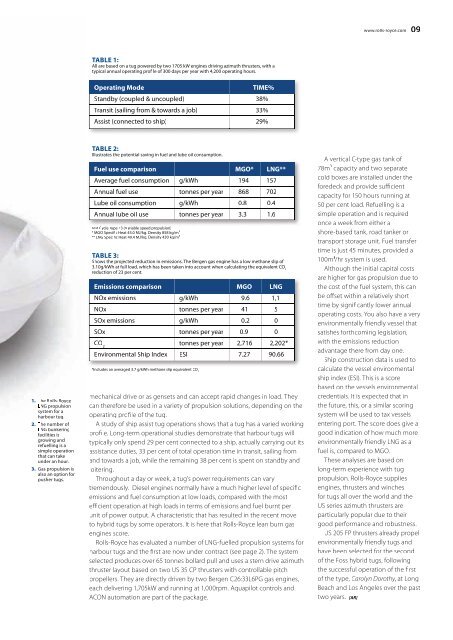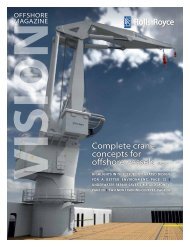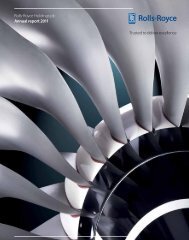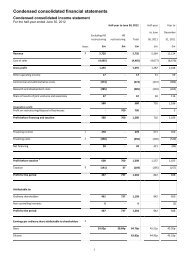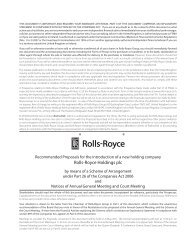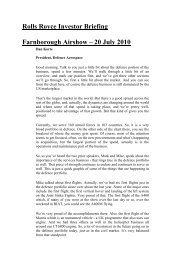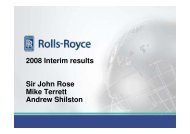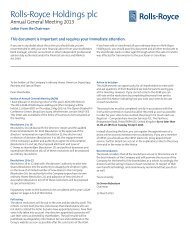In-depth Issue 17 - Rolls-Royce
In-depth Issue 17 - Rolls-Royce
In-depth Issue 17 - Rolls-Royce
You also want an ePaper? Increase the reach of your titles
YUMPU automatically turns print PDFs into web optimized ePapers that Google loves.
www.rolls-royce.com<br />
09<br />
TABLE 1:<br />
All are based on a tug powered by two <strong>17</strong>05 kW engines driving azimuth thrusters, with a<br />
typical annual operating profile of 300 days per year with 4,200 operating hours.<br />
Operating Mode<br />
TIME%<br />
Standby (coupled & uncoupled) 38%<br />
Transit (sailing from & towards a job) 33%<br />
Assist (connected to ship) 29%<br />
1. The <strong>Rolls</strong>-<strong>Royce</strong><br />
LNG propulsion<br />
system for a<br />
harbour tug.<br />
2. The number of<br />
LNG bunkering<br />
facilities is<br />
growing and<br />
refuelling is a<br />
simple operation<br />
that can take<br />
under an hour.<br />
3. Gas propulsion is<br />
also an option for<br />
pusher tugs.<br />
TABLE 2:<br />
Illustrates the potential saving in fuel and lube oil consumption.<br />
Fuel use comparison MGO* LNG**<br />
Average fuel consumption g/kWh 194 157<br />
Annual fuel use tonnes per year 868 702<br />
Lube oil consumption g/kWh 0.8 0.4<br />
Annual lube oil use tonnes per year 3.3 1.6<br />
Test<br />
Cycle Type<br />
E3 (Variable speed propulsion)<br />
* MGO Specific Heat 43.0 MJ/kg. Density 858 kg/m³<br />
** LNG Specific Heat 49.4 MJ/kg. Density 430 kg/m³<br />
TABLE 3:<br />
Shows the projected reduction in emissions. The Bergen gas engine has a low methane slip of<br />
3.10g/kWh at full load, which has been taken into account when calculating the equivalent CO 2<br />
reduction of 23 per cent.<br />
Emissions comparison MGO LNG<br />
NOx emissions g/kWh 9.6 1,1<br />
NOx tonnes per year 41 5<br />
SOx emissions g/kWh 0.2 0<br />
SOx tonnes per year 0.9 0<br />
CO 2<br />
tonnes per year 2,716 2,202*<br />
Environmental Ship <strong>In</strong>dex ESI 7.27 90.66<br />
*<strong>In</strong>cludes an averaged 3.7 g/kWh methane slip equivalent CO 2<br />
mechanical drive or as gensets and can accept rapid changes in load. They<br />
can therefore be used in a variety of propulsion solutions, depending on the<br />
operating profile of the tug.<br />
A study of ship assist tug operations shows that a tug has a varied working<br />
profile. Long-term operational studies demonstrate that harbour tugs will<br />
typically only spend 29 per cent connected to a ship, actually carrying out its<br />
assistance duties, 33 per cent of total operation time in transit, sailing from<br />
and towards a job, while the remaining 38 per cent is spent on standby and<br />
loitering.<br />
Throughout a day or week, a tug’s power requirements can vary<br />
tremendously. Diesel engines normally have a much higher level of specific<br />
emissions and fuel consumption at low loads, compared with the most<br />
efficient operation at high loads in terms of emissions and fuel burnt per<br />
unit of power output. A characteristic that has resulted in the recent move<br />
to hybrid tugs by some operators. It is here that <strong>Rolls</strong>-<strong>Royce</strong> lean burn gas<br />
engines score.<br />
<strong>Rolls</strong>-<strong>Royce</strong> has evaluated a number of LNG-fuelled propulsion systems for<br />
harbour tugs and the first are now under contract (see page 2). The system<br />
selected produces over 65 tonnes bollard pull and uses a stern drive azimuth<br />
thruster layout based on two US 35 CP thrusters with controllable pitch<br />
propellers. They are directly driven by two Bergen C26:33L6PG gas engines,<br />
each delivering 1,705kW and running at 1,000rpm. Aquapilot controls and<br />
ACON automation are part of the package.<br />
A vertical C-type gas tank of<br />
78m3 capacity and two separate<br />
cold boxes are installed under the<br />
foredeck and provide sufficient<br />
capacity for 150 hours running at<br />
50 per cent load. Refuelling is a<br />
simple operation and is required<br />
once a week from either a<br />
shore-based tank, road tanker or<br />
transport storage unit. Fuel transfer<br />
time is just 45 minutes, provided a<br />
100m3/hr 3<br />
system is used.<br />
Although the initial capital costs<br />
are higher for gas propulsion due to<br />
the cost of the fuel system, this can<br />
be offset within a relatively short<br />
time by significantly lower annual<br />
operating costs. You also have a very<br />
environmentally friendly vessel that<br />
satisfies forthcoming legislation,<br />
with the emissions reduction<br />
advantage there from day one.<br />
Ship construction data is used to<br />
calculate the vessel environmental<br />
ship index (ESI). This is a score<br />
based on the vessels environmental<br />
credentials. It is expected that in<br />
the future, this, or a similar scoring<br />
system will be used to tax vessels<br />
entering port. The score does give a<br />
good indication of how much more<br />
environmentally friendly LNG as a<br />
fuel is, compared to MGO.<br />
These analyses are based on<br />
long-term experience with tug<br />
propulsion. <strong>Rolls</strong>-<strong>Royce</strong> supplies<br />
engines, thrusters and winches<br />
for tugs all over the world and the<br />
US series azimuth thrusters are<br />
particularly popular due to their<br />
good performance and robustness.<br />
US 205 FP thrusters already propel<br />
environmentally friendly tugs and<br />
have been selected for the second<br />
of the Foss hybrid tugs, following<br />
the successful operation of the first<br />
of the type, Carolyn Dorothy, at Long<br />
Beach and Los Angeles over the past<br />
two years. [AR]


